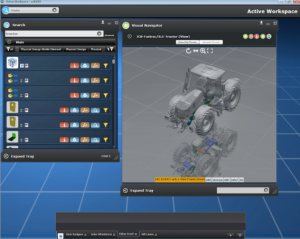
Product lifecycle management, or PLM, describes the process of developing a product from the initial idea phase through to design, manufacturing, service and disposal. Unlike other types of project management, PLM is a holistic approach that considers the entire life of a product. This is increasingly important in the modern manufacturing atmosphere because products are increasingly complex, especially those that require ongoing maintenance and support after their release.
Because there are so many steps involved in creating and releasing a new product, and each step may be attended to by a variety of workers, departments or even industries, strong organization is vital. This becomes even more important when a company outsources elements of its manufacture or design; in these situations, communication is paramount. Having a robust PLM software solution that helps to monitor the progress of a developing product will help to boost efficiency and ensure that everyone working on a project is on the same page.
Fortunately, a variety of Product Life Cycle Management Software programs exist to serve this need.
This project management software works to provide document organization and project insights that can be modified or adjusted as necessary to suit the needs of the business that employs it. From small businesses to major industrial corporations, any company that handles product development and manufacturing can benefit from a good lifecycle management software.
Does Your Business Need Product Life Cycle Management Software?
Although many businesses can benefit from implementing an organized PLM system with the help of specially designed software, such PLM platforms are not necessarily the right choice for everyone. There are problems that are signs that a business may benefit from a more streamlined and systematized approach:
Projects gone wrong. If a project is over-staying its welcome, it may be due to poor opportunities for rational assessment. This can occur when the data about a project’s viability is difficult to access or cannot be assessed without subjective assumptions. By making data available objectively to decision-making bodies and removing the human element from the equation, a PLM system can prove very effective in weeding out poor project choices.
Communication failures and complications. This is the biggest benefit to any sort of project management software, and it’s especially crucial for product development that may span numerous teams, businesses and even industries. If communication with manufacturing partners or suppliers breaks down, it can cause major delays in production. Centralized PLM communication reduces the clumsiness and delays caused by manual communication and ensures that communication errors are kept to a minimum. Centralized communication and document storage reduces time-consuming and tedious faxes, file transfers, phone calls and other related steps.
Regulatory requirements that require a paper trail. Electronic traceability is another major benefit of a software-based PLM system. Having all communications, data and documents stored in a centralized place makes it easy to look back over a project and see the “paper trail” of communication and development. This can be essential for ensuring a product meets or exceeds compliance requirements.
Costs out of control and rising? PLM systems are especially valuable in situations where companies may outsource some or all a product’s design, development or service. If a business is considering heavily outsourcing future projects, the PLM platform can provide a space for collaboration while also allowing for evaluation of the manufacturing and supply chain. Being able to see the project through a “big picture” lens can be crucial for identifying places where expenses can be trimmed without sacrificing quality.
By carefully considering your company’s business needs, you can best decide whether a PLM system is appropriate. Not every product manufacturing or design company can benefit from this type of software, but it can be a valuable tool for those who require the added organization and optimization potential of a good PLM program.
The PLM Software Solution
As an acronym, PLM is often used for both the process of lifecycle management as well as the software that manages this process. This can add a  layer of confusion when talking about PLM, especially when a business is deciding whether or not to implement a PLM system.
layer of confusion when talking about PLM, especially when a business is deciding whether or not to implement a PLM system.
In general terms, all product development projects will utilize some type of lifecycle management system. This system may not, however, always be formally organized into a dedicated software program. The business may, for example, utilize a series of guidelines or practices for data analysis, communication and document gathering; all of these processes would be considered aspects of PLM.
Dedicated software simply acts to make this process more organized and efficient by providing a single accessible platform through which to access all of these diverse elements and share them across multiple teams so that everyone working on a project can have access to what they need to complete their part of the job.
The purpose of a PLM system is to streamline the increasingly complex challenges of product development. Modern technologies are more complicated than ever to design, market and support, and the demands of a global market mean that products must be of topmost quality. A thoroughly organized approach to the product lifecycle is one important step to establishing a solid foundation for a product launch.
The primary benefit of an organized PLM system is greater efficiency. When every step of product development is managed through a centralized software system, communicating with team members and identifying ways to simplify the process become simpler. This produces several additional perks:
- Reduced production time from idea to market.
- Lowered costs for prototyping and production.
- More accurate quote generation and timeline approximation.
- Higher profits as a result of more efficient processes.
Maximizing efficiency allows a business to reduce waste, boost product optimization and otherwise streamline the process of developing a product.
Who Uses PLM Software?
Lifecycle management software is designed to serve as an information management system, or a way to manage workflow and keep tabs on the many different aspects of a product’s life cycle. By keeping all necessary information in a single centralized location, this type of software allows the user to follow a product’s development from initial ideation through to manufacture, service and eventually disposal.
PLM can apply to any type of technology and is not limited to a specific type of product. This type of software can be used by companies working in:
- Product data management
- Computer-aided design and manufacturing
- Digital manufacturing
- Manufacturing operations management
- Predictive engineering analytics
How Product Lifecycle Management Software Works
There are multiple types of PLM systems on the market, and each software will have its own features and benefits. In general, however, certain elements are essential to quality product lifecycle management. Any software platform should:
- Establish a centralized record-keeping system that can be accessed and shared by all relevant departments or employees.
- Improve efficiency through optimization of systems and processes necessary to drive product development.
- Boost revenues and overall value through maximized efficiency and cutting of unnecessary or redundant steps and processes.
Proper organization is the key to ensuring smooth workflow and project management, and choosing the right type of PLM tools will help to achieve this goal.
Common Software Features
The setup and layout of software for PLM will vary somewhat between programs, and different users may prefer certain interfaces over others. Depending on the needs of an individual project, some or all of these PLM program features may be helpful:
Collaboration tools that allow for social networking or communication across teams. These may include in-software messaging platforms, note-taking capabilities and other tools that expedite the spread of information between teams working on a project.
Lifecycle intelligence data analysis and collection. These tools enable a user to leverage data for better decision making and process optimization. By collecting all of the relevant data in one place and providing tools for its assessment and analysis, a PLM platform makes it easy to identify patterns and create projections.
Product data management resources. Having a centralized location to store project data, including portfolio and bid information, allows for better organization.
A PLM solution should work to manage information and processes, acting as a centralized platform for data collection and communication. In other words, every document related to a product’s design, manufacturing and release should be stored in a PLM program in such a way that it can be readily accessed by all required team members.

The ideal PLM program will be specialized to the target industry. This will ensure that the solutions offered are appropriate for the individual needs of a company without additional unnecessary features that may bog down the program or make the software more difficult to use. The best PLM systems make workflow and planning simpler, not more complex.
What to Look for in PLM Software
With multiple software options available on the market, it’s important to look for the program that will best suit your needs. As with any software, not all PLM systems are created equal, and some of the more robust features may be more important for some users than others. Nevertheless, there are a handful of features to consider when searching for a PLM system:
Ease of use. If the software is not easy to navigate, team members will not want to use it or will struggle with learning how to use it. This will slow down training and encumber workers, canceling out the optimization and efficiency value of implementing the system in the first place.
System integration. Most businesses already utilize some form of project management system. A good PLM program should seamlessly integrate with your other enterprise systems or be powerful enough to replace them.
Support for existing processes. Your PLM system should work within the existing workflow and expectations. Unless your business operations require a massive overhaul, it is best to make subtle changes that will boost efficiency without destroying what already works.
Flexibility and accessibility. The greatest benefit of a PLM platform is the ability to communicate and stay organized across different teams, businesses and industries. With this in mind, the software you choose needs to be accessible to every group you wish to work with.
Speed of implementation. Installing the software, training employees in its use and integrating it into daily workflow processes should not be unduly time-consuming. This is why it is so important to choose a system that is sufficiently robust while staying accessible and easy to use.
Overall, the single most important thing to remember about any type of project management software is that it exists to make work processes more efficient. Any software that slows down development or creates additional and unnecessary complications is working counter to that primary goal.
Benefits of Utilizing PLM Solutions
PLM software solutions are especially important at the outset of a project, when having a firm plan in mind can help with its development and launch. Through centralizing project information and managing communication, workflow on a project can be optimized. This makes it much easier to collaborate across departments.
Where PLM platforms truly shine is in the way they simplify the process of applying changes or modifications. If a new process must be implemented, the centralized communication tools in the software make it easy to keep everyone on the same page.
Similarly, because all project data can be stored in the same location, the risks of miscommunication can be mitigated. Everyone who needs to know some vital piece of information about a project will have access to it without needing to rely on any external forms of communication. Having product information stem from a single source helps to reduce the risk of errors and ensures that information is delivered to the correct team at an appropriate time.
Businesses that employ PLM systems enjoy many benefits:
- More likelihood of meeting product launch dates.
- Increased chances of meeting cost and revenue targets.
- Reductions in development time due to improved efficiency.
- Better product quality.
In general, these benefits arise organically from the improved communication and organization afforded by the software. In other words, businesses will only get value from a PLM system if they utilize that system as part of an overall push toward greater organization. If not incorporated into a holistic project management approach, these results may not be as dramatic.
Things to Consider Before Implementing PLM Software
Although software for project lifecycle management can be a smart business investment, there are still things to consider before purchasing or implementing this type of solution. The specific challenges or drawbacks encountered by a business may vary depending on the way projects have been managed in the past; an honest assessment of a company’s current processes and their strengths and weaknesses can help to ease the transition.
Some things to consider:
Are there any project management systems already in place? If not, you may require additional training to get your team on board with how to use the system. Establishing “best practices” for using the software at the outset will streamline the process and ensure that it works to improve efficiency rather than create an additional technological hurdle for users.
If you already have a project management system, will the PLM software replace or augment it? If your team is already trained to use one type of project management system, it may be a challenge to add another or transition between them. You may wish to see whether your existing tools could be adapted to fill the needs of a PLM system. If not, be sure to establish specific rules for how each program is used, or choose a PLM program that will fulfill all project management needs so it can replace an existing system. Otherwise, you may face confusion and poor organization as workers try to juggle two competing systems.
Do you have clear goals for what the PLM system will help you to accomplish? A project management software is a tool, and like any tool, it is only effective when put to use with a purpose. Software cannot solve productivity or efficiency problems on its own; it must be implemented with strategic goals and used toward achieving those goals. The first step to ensuring the effectiveness of a PLM system is understanding exactly what the software is and is capable of; the second step is training your team on its use so that this value can be communicated.
Armed with an understanding of PLM systems and what they can do to improve a business, you can make an informed decision about the software you acquire and how to best implement it to achieve your goals.
By doing this research in advance and taking the time to train your team, you can reap the benefits of a product lifecycle management software solution for your project management needs.

